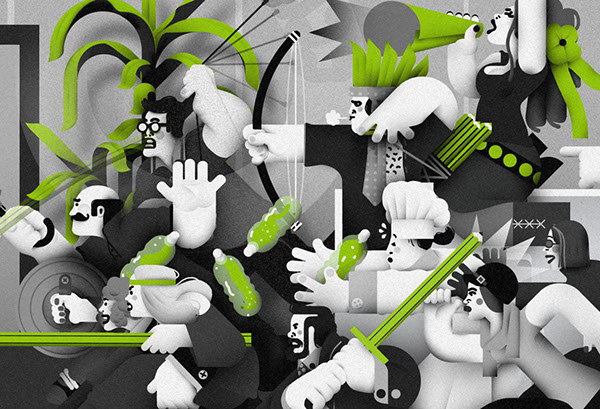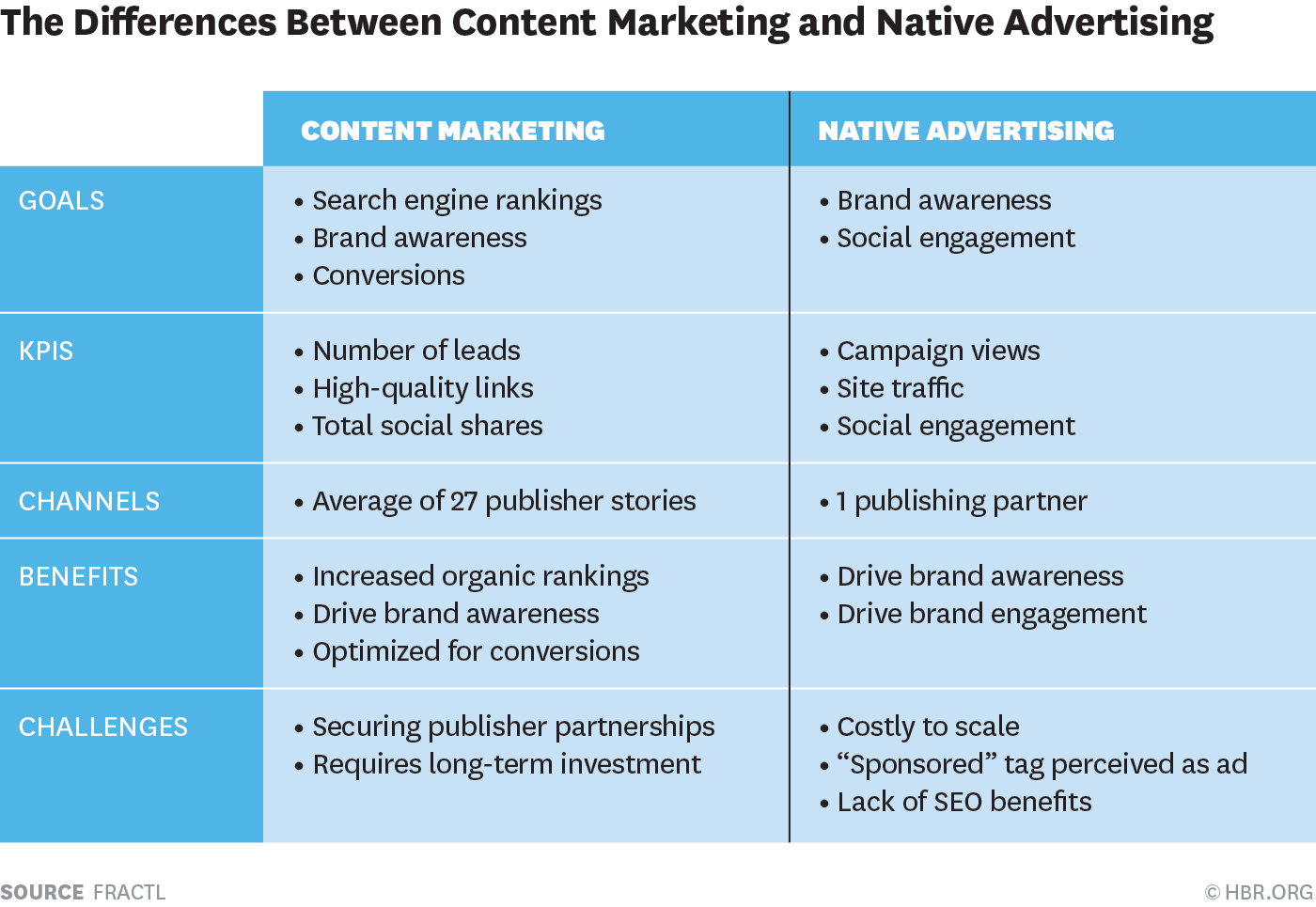Comparing ROI for Native Advertising and Content Marketing

Content marketing expert and columnist for Harvard Business Review Kelsey Liebert talks about research at Fractl . They collected data from 600 media sites, 30 agencies and found out how much brands spend on content marketing, how much on native advertising and what they get in the end.
The material is translated by the New Night team for Relap.io .
Many companies rely on content marketing and native advertising to ensure brand awareness.
')
70% of people say they would prefer to learn about products from content, rather than from traditional advertising.
But what, content marketing or native advertising, most likely increase awareness? Which of the channels will give the highest return at the lowest cost?
To answer these questions, we at Fractl (doing content marketing) have teamed up with Moz and researched data from over 30 content marketing agencies for content formats and metrics that they use to evaluate ROI. Back to the results later. First, let's remember what the difference is between approaches and what each of them is aimed at.
Content marketing agencies create campaigns for brands ( here is an example ), and then offer them to top-end media for publication. In each material, the publication gives a return link to the brand as a source. These links increase the company's position in search results, increase direct traffic and increase user involvement through social networks.
If the goal of content marketing is, as a rule, coverage of one case in dozens of media outlets, then native advertising is paid content promotion on a single site. ( Here is an example of cooperation between Laundry Detergent and BuzzFeed. ) Native advertising (also known as sponsored content) is guaranteed placement on a top site with multi-million traffic.

Based on the data, we compared the effectiveness of content marketing and native advertising. Here is a detailed account of what we have learned .
First of all, we looked at how content marketing agencies work. On average, 65% of agencies create from 1 to 10 campaigns per month for each client. Creating a single campaign involves generating an idea, researching a concept, creating a product, and the last step is promoting. After the team has completed product creation, it goes into the hands of the PR department. Objective: To make the regular authors of authoritative publications write campaign material.
When content marketing first appeared, “lists” and widgets were the dominant format. As soon as Google began to punish brands for irrelevant content and links, the industry came to life. Like many publishers , content marketing agencies started creating branded articles and infographics.

Almost half of clients measure the success of content marketing with the number of leads (converted users coming from the campaign page), high-quality links (links to reputable websites) and the number of shares in social networks. Without taking into account the anomalous values, the usual content marketing campaign collects 27 links in the media. Campaigns that agencies call “most successful” are 422 links. Median - 150.
How much is it? We found that 70% of agencies work on a monthly fix. The cost of services can be divided into five categories: less than $ 1,000, $ 1,000– $ 5,000, $ 5,000– $ 10,000, $ 10,000– $ 50,000 and $ 50,000– $ 10,000. The price is determined by the amount of work (compare press release and interactive graphics) and the required coverage (with the involvement of agents of influence or without promotion). We found that the largest number of links falls on campaigns ranging from $ 5,000 to $ 50,000. This means that agencies had the opportunity to create high-quality content, ensure audience coverage, attract opinion leaders, achieve strong influence, and not just send out press releases.
Among the campaigns with low cost, we did not notice such activity. We suspect that agencies simply did not have enough resources to generate complex ideas. What is interesting, we noticed: the effectiveness of the campaign does not significantly increase when the price exceeds $ 50,000.
The next step was to find out what is the difference between native advertising. We collected data on the cost of native advertising from the report of the company Relevance (another content marketing agency), to which we added our own. For example, about 600 publishers understand what price they charge for placement. In the sample, we included news sites that dominate the search results and in total have more than 100,000 subscribers in social networks.
At first glance it can be seen that the minimum investment in such a partnership is overwhelming for most brands. For example, native advertising at TIME can cost a client up to $ 200,000. On average, the cost of native advertising in top media was $ 54,014.29. For less prestigious sites with a “domain influence” less than 80, the average cost of placement is from $ 70 to $ 8000.
Relap Comment
The cost of such placement in the Russian edition with traffic of 1-2 million per day comes to 200,000 rubles for one text. Details read in our material:
Why native advertising has become the main trend of the media and how to implement it on Russian sites
Obviously, native advertising is expensive. But what is the return? We reviewed 38 native campaigns published on BuzzFeed (the leader in the market of sponsored content) and 58 content-marketing campaigns of Fractl) We compared coverage (number of links) and involvement (social media).
Links to Fractl campaigns were shared more often and they received more repost than BuzzFeed publications.
If we compare only the most successful cases, then the 11 campaigns prepared by Fractl for Movoto collected an average of 146 links in the media and 17,934 reposts in social networks. While 13 campaigns for Intel, prepared by BuzzFeed, were mentioned only once in the media and on average received 12,481 reposts.
Similar results are published in a report from eMarketer . They found that the most common problem, according to those who use native advertising, is its scale.
If you pay for posting content only on the site with which you cooperate, this limits the potential coverage.
Another problem: Google considers native advertising as a purchased link . This prevents brands from taking high positions in search results.
With less audience reach, is native advertising worth the required investment? For some companies with a big budget, yes. If, after this, the brand is associated with a reputable publication, and the campaign exactly hits the target audience. In the end, native advertising has proven its effectiveness in terms of clickability compared to traditional banners and other formats that direct the user to the advertiser's site. Alternatively, it may make sense.
I may be biased, but research based on data shows that companies benefit more at lower costs when they use content marketing. Especially if the goal - a wide coverage of different audiences at different sites. For those who are interested in guaranteed placement and the name of the publication, native advertising can be a tool.
If you have a content or a blog, and you want more people to watch it, we will help you find an audience.
Write to ads@relap.io
We work with RIA News, AdMe, COUB, TJournal, Layfhaker. Helped find audiences projects Aviasales, Tinkoff, Invisible and many others.
Source: Comparing the ROI of Content Marketing and Native Advertising
Author: Kelsey Libert is a marketing specialist and partner of Fractl agency and the author of MarketingLand , Harvard Business Review and HubSpot blog .
Translation: Polina Pilyugina for Night and Relap.io
Source: https://habr.com/ru/post/298448/
All Articles